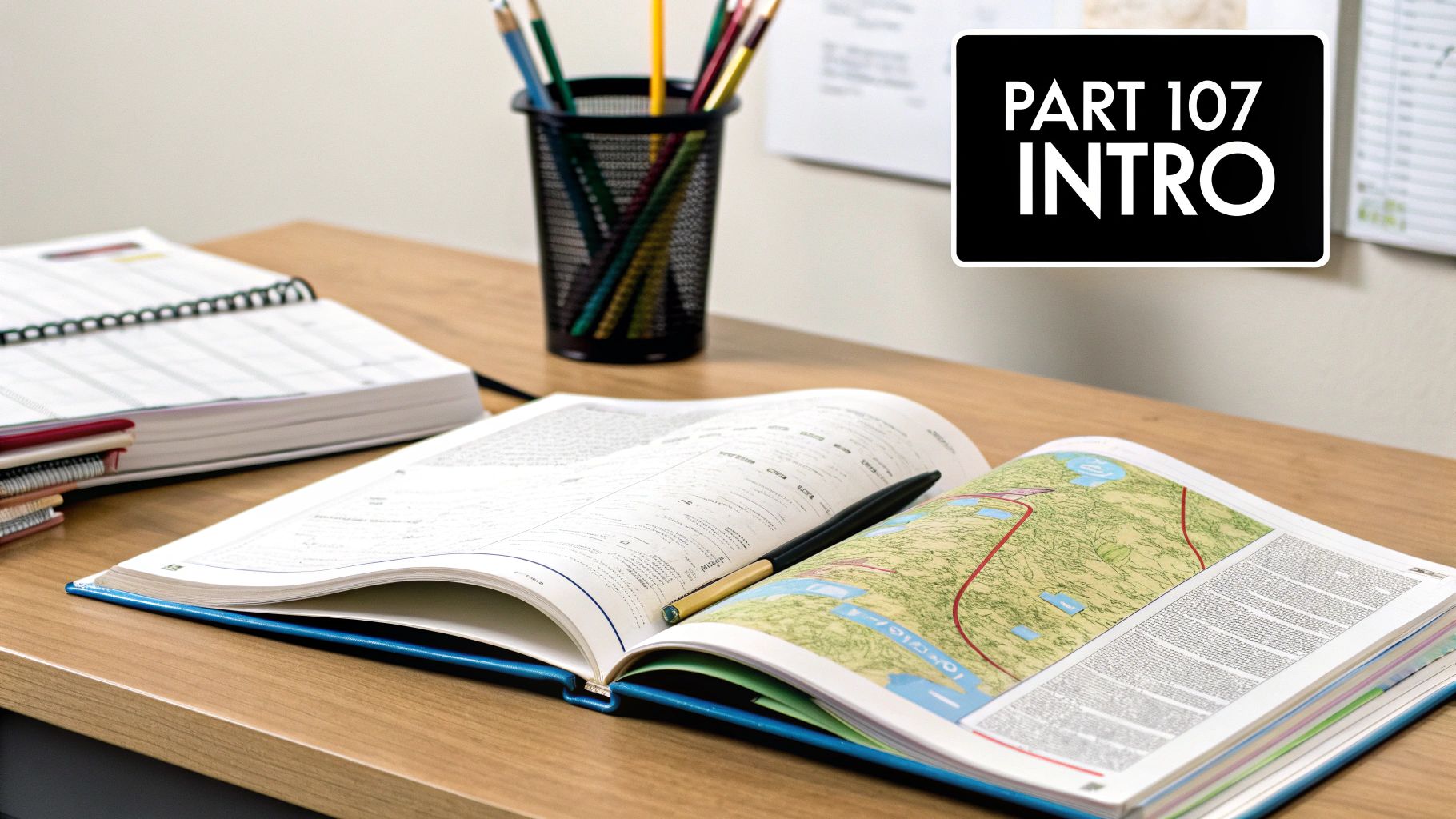Part 107 Study Guide: Conquer FAA Certification
- James Baptiste

- Apr 13
- 11 min read
Updated: Apr 14
Breaking Down the Part 107 Exam: What You're Really Facing

Before diving into your Part 107 studies, it's helpful to understand the exam's structure. This allows for a more focused and strategic approach to your Part 107 study guide, maximizing your preparation time. Knowing how the exam works is just as important as the content itself, setting you up for success.
Demystifying the Exam Structure
The Part 107 exam presents 60 multiple-choice questions. This format offers a strategic advantage. Even if you're unsure of an answer, eliminating one incorrect option increases your chances of guessing correctly. You need 70% to pass, meaning you can miss up to 18 questions. This provides a cushion, alleviating some pressure.
Key Knowledge Areas
A good Part 107 study guide covers all exam topics, but some areas hold more weight. Airspace regulations, weather interpretation, and operational procedures are consistently emphasized as crucial. However, don't neglect other topics. A balanced approach, with extra focus on these key areas, is often most effective. Understanding the requirements for a drone pilot license is fundamental for commercial drone operations.
Since the FAA introduced the regulations in 2016, the Part 107 study guide and exam have become increasingly popular. Approximately 88% of test-takers pass on their first attempt, demonstrating the effectiveness of available study resources. The exam's multiple-choice format, with three options per question, contributes to this high success rate. You can find more about Part 107 resources and statistics here.
Avoiding Common Pitfalls
Memorization alone isn't enough. While knowing the rules is crucial, understanding their practical application is equally important. The exam often presents scenarios requiring you to apply your knowledge, not just recall facts. Practice with real-world examples is key. Another pitfall is exam anxiety. A calm and focused mindset will significantly improve your performance.
Navigating the Airspace Puzzle: Your Biggest Exam Challenge

Airspace regulations are a critical component of the Part 107 exam. Understanding these rules is essential not only for passing the test but also for conducting safe and legal drone operations. Think of airspace as a complex system with various classifications, each having its own set of rules.
Understanding Airspace Classifications
Airspace is categorized into classes from A to G. Class A is the most restrictive, while Class G is the least. Each class has specific altitude limits and operational requirements.
For example, Class B airspace, which usually surrounds busy airports, requires explicit authorization from Air Traffic Control (ATC) before any drone flight. This contrasts sharply with Class G airspace, where prior authorization isn't typically required for Part 107 drone operations.
Let's explore the different airspace classifications in more detail:
To understand these classifications better, let's look at the table below.
Airspace Classifications for Drone Operations This table provides a comprehensive overview of different airspace classifications and their implications for drone operations under Part 107 rules.
Airspace Class | Altitude Range | Authorization Required? | Key Characteristics | Common Locations |
|---|---|---|---|---|
Class A | 18,000 feet MSL and above | Yes | Generally prohibited for drones | Above 18,000 feet |
Class B | Surface to 10,000 feet MSL | Yes | Surrounds busy airports | Major airports |
Class C | Surface to 4,000 feet AGL | Yes | Around medium-sized airports | Mid-sized airports |
Class D | Surface to 2,500 feet AGL | Yes | Smaller airports | Small airports, military airfields |
Class E | Varies | Generally not required, but can be complex based on specific area | Extends from designated altitudes to the base of Class A | Controlled airspace not A, B, C, or D |
Class G | Surface to the base of the overlying controlled airspace (A, B, C, D, or E) | Generally no | Uncontrolled airspace | Most common airspace for drone operations |
This table clearly illustrates the varying requirements and characteristics of each airspace classification, highlighting the need for careful planning and adherence to regulations for all drone pilots.
Decoding Sectional Charts
Sectional charts are essential tools for drone pilots. These charts provide a visual representation of airspace classifications, restricted areas, and other important information. Proficient remote pilots learn to quickly interpret the markings on these charts.
For example, restricted areas are often depicted as clearly defined shapes, making them easily identifiable. This ability to interpret sectional charts is vital for both the exam and real-world drone operations.
Practical Application of Airspace Knowledge
Understanding airspace regulations is one thing; applying that knowledge is another. Imagine planning a drone flight near an airport. The first step is to consult the sectional chart and identify the airspace classification. This will determine whether authorization is needed and any operational limitations.
Another scenario might involve Temporary Flight Restrictions (TFRs), often implemented for events or emergencies. Understanding how to access and interpret TFR information is crucial for legal drone operations.
Mastering Airspace for Exam Success
A strong grasp of airspace regulations is often what separates successful exam takers from those who don't. Exam questions often test your ability to interpret scenarios and apply the correct airspace rules. Recent changes in regulations, such as those related to Remote ID, further emphasize this importance.
The Part 107 exam has evolved to include more detail on airspace, weather, and drone operations. For instance, study guides now place increased emphasis on understanding sectional charts and rules related to air traffic control and airport operations. You can find more information about recent changes here.
By understanding each airspace class and how to use sectional charts, you'll be prepared for even the toughest exam questions. This knowledge will also create a solid foundation for safe and compliant commercial drone operations as a certified remote pilot. Mastering airspace isn't just about passing an exam; it's about operating responsibly and contributing to the safe integration of drones into the airspace.
Weather Mastery: Reading The Skies Like A Pro

Weather plays a critical role in drone operations, directly affecting both safety and the legality of flights. This section of your Part 107 study guide will equip you with the knowledge to understand how weather impacts drone flight and how to make sound decisions based on weather data. This information is frequently tested on the Part 107 exam.
Decoding METARs and TAFs
METARs (Meteorological Aerodrome Reports) and TAFs (Terminal Aerodrome Forecasts) are vital sources of weather information. Understanding these reports is fundamental for any aspiring remote pilot. While their coded format may initially seem complex, learning to identify the key components will make interpretation much easier.
For instance, a METAR might look like this: "KLAX 241853Z 32005KT 10SM FEW040". This string of characters provides specific conditions at Los Angeles International Airport (KLAX) at a particular moment in time. Being able to decode wind speed, visibility, and cloud cover is essential for success on the Part 107 exam.
Recognizing Dangerous Weather Patterns
Certain weather conditions pose significant hazards for drone operations. Strong winds, thunderstorms, and low visibility substantially increase the risks involved. In addition, icing can be a serious concern, potentially affecting both the drone's performance and your ability to control it.
This means that recognizing which cloud formations indicate potential turbulence or precipitation is crucial. For example, cumulonimbus clouds, often associated with thunderstorms, are a definite signal to avoid drone flights. Recognizing these warnings will protect your equipment and ensure your operations remain compliant.
Utilizing Trusted Weather Apps
Weather apps are essential tools for remote pilots. However, it's important to remember that not all apps are equal. Some are inherently more reliable and provide more pertinent data specifically for drone operations. Finding trustworthy sources is a critical skill.
Understanding the limitations of standard weather forecasts is also important. Microclimates, localized weather patterns that can vary drastically from broader forecasts, can be a decisive factor. Seasoned drone pilots often learn techniques for recognizing these microclimates to bolster flight safety.
Real-World Weather Decision Making
Imagine you are preparing for a drone mapping mission. The general forecast predicts clear skies. However, observing a rapid drop in temperature coupled with a decreasing dew point spread suggests the possibility of fog formation. This is where your weather interpretation skills, going beyond the basic forecast, become truly valuable.
This kind of real-world scenario often appears in Part 107 exam questions. The exam tests not only your knowledge of the facts but also your ability to apply them practically. Therefore, practice interpreting weather data and making well-informed decisions. Mastering weather interpretation is a key step in becoming a safe and competent drone pilot.
Regulations Decoded: The Rules That Actually Matter

This section of your Part 107 study guide zeroes in on the most important regulations. Instead of trying to memorize everything, we'll focus on the rules the FAA really cares about, both for enforcement and for the exam. This approach helps you grasp the core safety principles for commercial drone operations.
Key Regulations: The Foundation of Safe Flight
Some regulations are absolutely fundamental to Part 107. These rules are non-negotiable and show up consistently on the exam. The 400-foot altitude ceiling, for example, is a critical limitation. Maintaining visual line-of-sight (VLOS) is another essential rule. These are designed to ensure drones operate safely within the national airspace.
But there's also some flexibility built into the system. Normally, operations are limited to daylight hours. However, waivers are available for night flights if you implement the right safety measures. So, a complete Part 107 study guide needs to cover not just the rules themselves, but also when waivers might be an option.
Navigating Operational Limitations
Part 107 has some other limitations you should be aware of, like speed restrictions. Effective commercial operators learn how to work within these boundaries. The maximum speed allowed is 100 mph. However, experienced pilots often choose to fly slower for better precision and safety margins, particularly for jobs like aerial photography or inspections.
Keeping good records is also essential for compliance. This includes things like pre-flight checklists and maintenance logs. Even if your flights are technically perfect, poor record-keeping can create regulatory headaches.
Common Pitfalls and How to Avoid Them
Some areas of the regulations tend to trip up drone pilots. One common problem area is operating near airports. This requires understanding airspace classifications and getting proper authorization. Operating in Class B airspace, the kind usually surrounding major airports, requires specific permission from Air Traffic Control.
Temporary Flight Restrictions (TFRs) are another area many pilots find challenging. TFRs are restrictions that can pop up unexpectedly and change where you’re allowed to fly. They might be issued for a big sporting event, a natural disaster, or other reasons. You must stay informed about active TFRs to avoid violations. Understanding these restrictions and how to find them is a big part of passing the Part 107 exam.
From Theory to Practice: Real-World Applications
Let’s look at a real-world scenario. Imagine a commercial operator wants to inspect a roof using a drone. They have to make sure the drone stays within VLOS, under 400 feet, and clear of any restricted airspace or active TFRs. They also have to keep detailed records of the flight, like the pre-flight check and maintenance logs.
This basic example shows how many different regulations can apply to even a simple commercial drone operation.
Part 107 Operational Limitations at a Glance
To help you quickly grasp the core limitations, here's a summary of some key Part 107 operational restrictions:
Limitation Type | Specific Requirement | Waiver Available? | Common Misconceptions |
|---|---|---|---|
Altitude | Maximum 400 feet above ground level (AGL) | Yes | Believing absolute altitude (MSL) is the limit, not AGL |
Speed | Maximum 100 mph (87 knots) | No | Thinking waivers exist for exceeding speed limits |
Visual Line-of-Sight (VLOS) | Drone must remain within unaided visual range of the Remote Pilot in Command (RPIC) | Yes | Assuming binoculars or spotting scopes satisfy VLOS requirements |
Daylight Operations | Operations limited to civil twilight | Yes | Misunderstanding the specific times of civil twilight |
Weight | Less than 55 pounds | No | Incorrectly calculating weight with attachments |
This table summarizes some of the most crucial limitations you'll encounter as a commercial drone pilot. Understanding these rules inside and out is key to successful and legal operations.
By concentrating on these highlighted regulations, you'll be well-prepared for the Part 107 exam and, more importantly, build a strong foundation for safe and compliant drone operations. Remember, the goal is not just to get the certificate, it’s to create a thriving and sustainable drone business.
Aircraft Performance: Why Your Drone Behaves That Way
Understanding your drone's performance in different situations is key for safe and efficient flights. This goes beyond simply passing the Part 107 exam; it's about making smart decisions in the real world.
Environmental Impacts: Beyond the Spec Sheet
Manufacturers often present performance data under ideal conditions. However, real-world flying rarely offers such perfect scenarios. Altitude, temperature, and humidity all play a significant role in how your drone performs, and these factors are frequently tested on the Part 107 exam.
At higher altitudes, the air is less dense. This means your drone's propellers must work harder to generate lift, ultimately reducing your flight time. High temperatures can also decrease battery efficiency. Increased humidity adds weight to the air, further impacting performance. These details aren't always readily available, but examiners expect you to understand these principles.
Calculating Realistic Flight Times and Payload Capacities
Don't just take the manufacturer's stated flight time at face value. It's crucial to adjust these figures based on anticipated conditions. If you're flying in hot weather or at a high altitude, expect a shorter flight time than what's advertised.
This principle also applies to payload capacity. A drone's rated payload under ideal conditions can significantly decrease in challenging environments. Accurately assessing these factors is crucial for mission planning and staying within safe operating limits. The Part 107 exam often includes questions that require you to calculate these adjustments.
Setting Personal Operational Limits: A Safety Net
Many experienced commercial drone operators set personal operational limits that are stricter than the FAA’s minimums. Think of it like driving – you might choose to drive slower than the speed limit in bad weather.
You might set a lower altitude limit for yourself than the regulatory 400 feet when flying in strong winds, or reduce your maximum payload on hot days. These self-imposed limits provide an extra layer of safety, protecting your equipment, your reputation, and the public.
Weight and Balance: The Hidden Factor
Even slight changes in weight distribution can significantly affect flight characteristics and battery life. Placing a camera a little forward or backward on your drone can shift its center of gravity, impacting stability and how it handles.
Imagine adding a heavier camera to your drone without adjusting its mounting position. This could shift the center of gravity forward, causing the drone to pitch down. The drone will then require more power to maintain level flight, reducing battery life and impacting stability. The Part 107 exam will assess your understanding of these adjustments.
Understanding these factors is crucial for any aspiring drone pilot. Visit JAB Drone for more resources on drone performance, regulations, and best practices for commercial drone operations.
Strategic Study Plan: How the Top 88% Actually Prepare
Passing the Part 107 exam on your first attempt isn't about luck; it's about having a solid strategy. Successful candidates approach the exam with a focused, strategic plan, saving time, money, and frustration. This section of your Part 107 study guide will explore the methods used by those who achieve first-attempt success.
Creating a Personalized Study Schedule
A well-structured study plan is the foundation of effective preparation. Instead of endless cramming, divide your study time into manageable segments, each focusing on specific topics. Prioritize key areas like airspace regulations and weather interpretation, while ensuring all exam topics are covered.
This personalized schedule should account for your current knowledge. If you're already familiar with aviation, you might spend less time on basic concepts and more on drone-specific regulations. This tailored approach is more efficient than generic study plans.
Science-Backed Memorization Techniques
Memorizing complex information like airspace charts and weather codes requires more than repetition. Techniques like active recall and spaced repetition are proven to enhance long-term retention. Active recall involves testing yourself regularly without looking at your notes. Spaced repetition means reviewing material at increasing intervals.
For example, after studying a weather code, try recalling it from memory. Review it again the next day, and then a few days later. This approach solidifies information in your long-term memory, crucial for exam success.
Choosing the Right Study Resources
A good Part 107 study guide is essential, but which resources provide the best value? While paid courses offer structure and expert instruction, free materials like FAA publications and online practice tests are invaluable supplements. Choosing the right combination is key.
The key is finding practice tests that mirror the current exam content. Outdated materials can cover irrelevant information, wasting valuable study time. Select current and relevant resources.
Psychological Preparation: Managing Exam Stress
The Part 107 exam can be stressful, but managing those nerves is crucial. Top performers use psychological preparation techniques to maintain focus and confidence. Visualizing success, practicing mindfulness, and deep breathing exercises can significantly reduce anxiety.
Even with tough questions, a strategy helps. If unsure of an answer, use the process of elimination. You can often rule out incorrect choices, improving your odds of selecting the right answer, even when uncertain.
Ready to take your drone piloting to the next level? Explore JAB Drone for comprehensive resources, product reviews, and expert advice to help you master the world of unmanned aerial vehicles.
Article created using [Outrank](https://outrank.so)




Comments